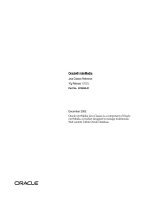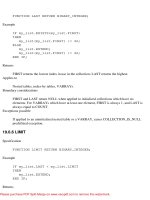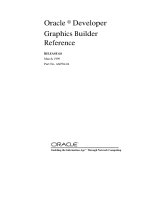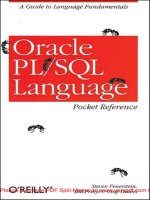Tài liệu Oracle PL/SQL Language Pocket Reference- P29 pptx
Bạn đang xem bản rút gọn của tài liệu. Xem và tải ngay bản đầy đủ của tài liệu tại đây (41.49 KB, 12 trang )
PROCEDURE DBMS_TRANSACTION.SAVEPOINT;
C.15.13 The
USE_ROLLBACK_SEGMENT procedure
The USE_ROLLBACK_SEGMENT procedure assigns the current transaction to the specified
rollback segment. This option also establishes the transaction as a read-write transaction. The
rollback segment specified must be online. You cannot use both the READ_ONLY and
USE_ROLLBACK_SEGMENT procedures within the same transaction. Read-only transactions do
not generate rollback information and thus cannot be assigned rollback segments. This procedure is
equivalent to the SQL command, SET TRANSACTION USE ROLLBACK SEGMENT. The
specification is:
PROCEDURE DBMS_TRANSACTION.USE_ROLLBACK_SEGMENT (rb_name
VARCHAR2);
C.15.14 The
BEGIN_DISCRETE_TRANSACTION procedure
The BEGIN_DISCRETE_TRANSACTION procedure streamlines transaction processing so short
transactions can execute more rapidly. During discrete transactions, normal redo information is
generated although it is stored in a separate location in memory. When the discrete transaction
commits, the redo information is written to the redo log file and data block changes are applied
directly. As such, there is no need for undo information in rollback segments. The block is then
written to the database file in the usual manner. The call to this procedure is effective only until the
transaction is committed or rolled back; the next transaction is processed as a standard transaction.
Any PL/SQL using this procedure must be coded to ensure that the transaction is attempted again in
the event of a discrete transaction failure.[3] The specification is:
[3] For more information on this topic, see "Using Discrete Transactions" in Oracle8
Server Tuning .
PROCEDURE DBMS_TRANSACTION.BEGIN_DISCRETE_TRANSACTION;
C.15.15 The
PURGE_MIXED procedure
The PURGE_MIXED procedure deletes information about a given in-doubt, distributed transaction
that has had mixed outcomes due to a transaction resolution mismatch. This occurs when an in-doubt,
distributed transaction is forced to commit or roll back on one node and other nodes do the opposite.
Please purchase PDF Split-Merge on www.verypdf.com to remove this watermark.
Oracle cannot automatically resolve such inconsistencies, but it does flag entries in the
DBA_2PC_PENDING view by setting the MIXED column to yes. When the database administrator
is sure that any inconsistencies for a transaction have been resolved, he or she can call the
PURGE_MIXED procedure.[4] The specification is:
[4] For more information on this topic, see "Manually Overriding In-Doubt
Transactions" in Oracle8 Server Distributed Systems .
PROCEDURE DBMS_TRANSACTION.PURGE_MIXED (xid VARCHAR2);
C.15.16 The
PURGE_LOST_DB procedure
The PURGE_LOST_DB procedure deletes information about a given in-doubt, distributed
transaction that has had mixed outcomes due to a lost database. This occurs when an in-doubt,
distributed transaction is able to commit or roll back on one node and other nodes have either
destroyed or recreated their databases. Oracle cannot automatically resolve such inconsistencies, as
described in PURGE_MIXED. The specification is:
PROCEDURE DBMS_TRANSACTION.PURGE_LOST_DB (xid VARCHAR2);
C.15.17 The
LOCAL_TRANSACTION_ID function
The LOCAL_TRANSACTION_ID function returns the unique identifier for the current transaction.
The function returns NULL if there is no current transaction. The specification is:
FUNCTION DBMS_TRANSACTION.LOCAL_TRANSACTION_ID
(create_transaction BOOLEAN := false)
RETURN VARCHAR2;
C.15.18 The
STEP_ID function
The STEP_ID function returns the unique positive integer that orders the DML operations of the
current transaction. The specification is:
FUNCTION DBMS_TRANSACTION.STEP_ID RETURN
VARCHAR2;
Please purchase PDF Split-Merge on www.verypdf.com to remove this watermark.
Previous: C.14 DBMS_SQL Oracle PL/SQL
Programming, 2nd Edition
Next: C.16
DBMS_UTILITY
C.14 DBMS_SQL
Book Index
C.16 DBMS_UTILITY
The Oracle Library
Navigation
Copyright (c) 2000 O'Reilly & Associates. All rights reserved.
Please purchase PDF Split-Merge on www.verypdf.com to remove this watermark.
Previous: C.15
DBMS_TRANSACTION
Appendix C
Built-In Packages
Next: C.17 UTL_FILE
C.16 DBMS_UTILITY
The DBMS_UTILITY package includes several utility modules you might find useful when
managing objects in the database.
C.16.1 The
ANALYZE_SCHEMA procedure
This procedure analyzes all the tables, clusters, and indexes in the specified schema. The
specification is:
PROCEDURE DBMS_UTILITY.ANALYZE_SCHEMA
(schema VARCHAR2,
method VARCHAR2,
estimate_rows NUMBER DEFAULT NULL,
estimate_percent NUMBER DEFAULT NULL);
C.16.2 The
COMMA_TO_TABLE procedure
The COMMA_TO_TABLE procedure parses a comma-delimited list and places each name into a PL/
SQL table. The specification is:
PROCEDURE DBMS_UTILITY.COMMA_TO_TABLE
(list IN VARCHAR2,
tablen OUT BINARY_INTEGER,
tab OUT uncl_array);
C.16.3 The
Please purchase PDF Split-Merge on www.verypdf.com to remove this watermark.
COMPILE_SCHEMA procedure
This procedure compiles all procedures, functions, and packages in the specified schema. The
specification is:
PROCEDURE DBMS_UTILITY.COMPILE_SCHEMA (schema VARCHAR2);
C.16.4 The
FORMAT_CALL_STACK function
This function formats and returns the current call stack. You can use this function to access the call
stack in your program. The specification is:
FUNCTION DBMS_UTILITY.FORMAT_CALL_STACK RETURN VARCHAR2;
C.16.5 The
FORMAT_ERROR_STACK function
This function formats and returns the current error stack. You might use this in an exception handler
to examine the sequence of errors raised. The specification is:
FUNCTION DBMS_UTILITY.FORMAT_ERROR_STACK RETURN VARCHAR2;
C.16.6 The
GET_TIME function
This function returns the number of 100ths of seconds which have elapsed from an arbitrary time.
Without GET_TIME, Oracle functions can only record and provide elapsed time in second intervals,
which is a very coarse granularity in today's world of computing. With GET_TIME, you can get a
much finer understanding of the processing times of lines in your program. The specification is:
FUNCTION DBMS_UTILITY.GET_TIME RETURN NUMBER;
C.16.7 The
IS_PARALLEL_SERVER function
This function helps determine if the database is running in Parallel Server mode. The specification is:
Please purchase PDF Split-Merge on www.verypdf.com to remove this watermark.









